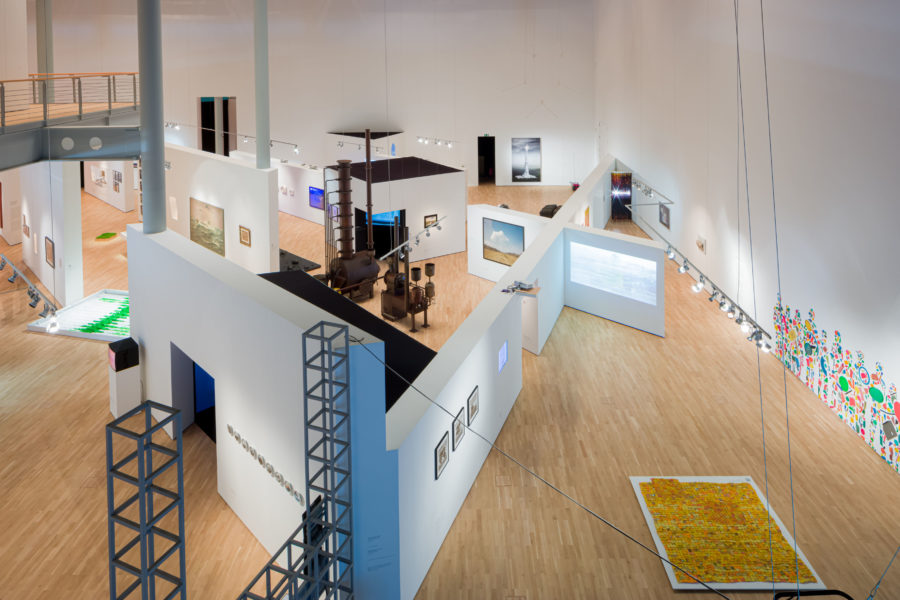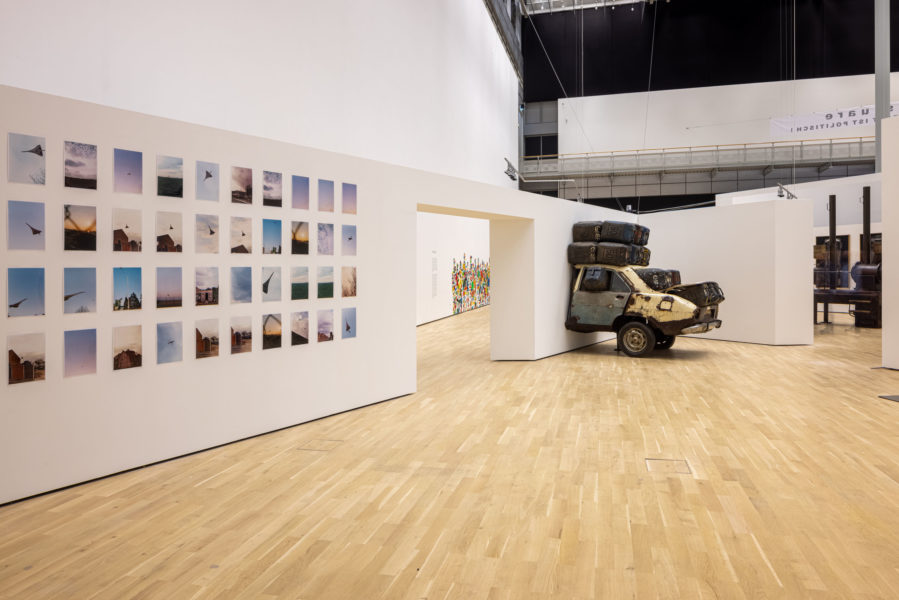Oil
Beauty and Horror in the Petrol Age
Images
Infos
No other substance has shaped societies in the twentieth and early twenty-first centuries as much as petroleum. Airplanes, tanks, and spacecraft, motorways, shopping malls and suburban settlements, nylon stockings, mountains of plastic, and vinyl – key materials and technologies, lifestyles and visions of our time owe their existence to the energy density and transformability of oil. Now, however, the dusk of the “petrol age” is looming, whereby neither can its end be precisely dated, nor its consequences adequately assessed. The exhibition Oil. Beauty and Horror in the Petrol Age therefore takes a speculative, poetic look back at the presence of the modern age of petroleum, which has lasted for roughly one hundred years. From the distance of a hypothetical future, we ask what was typical of our time, what was great and beautiful, what was ugly and terrible, and how all this is reflected in art and culture.
Fundamental here is the observation of a deep conflict: In the oil boom of the 1950s and 1960s, gasoline and kerosene, plastic, asphalt, and synthetic fibers stood for the futuristic promises of boundless mobility, individual freedom, and unrestricted transformability. Today, they are associated with global battles over resources, mountains of waste, and global warming, as well as sea and air pollution.
The exhibition focuses on all this from a fictitious archaeological distance and at the same time seeks a thematic and emotional proximity: Beyond entrenched ideology, it confronts works of art with natural science and technology, politics and everyday life, with knowledge, practices, and apparatus from chemistry, drilling, and geology, from daily working life and pop culture, from industry and cultural theory. Well-known and lesser-known works of art from the canon of Western modernism, as well as from oil-producing regions around the globe, are reappraised in the black mirror of oil and placed in relation to current artistic positions.
The exhibition focuses on the decades between the end of the Second World War and today. The cultural, technical, and geological constellations presented range, however, from the Middle Ages and antiquity to the early history of culture and life, while at the same time anticipating developments that may extend hundreds or even thousands of years into the future.
In this way, the exhibition presents the world’s first retrospective of the global modern age of petroleum.
Participating artist (selection):
Monira Al Qadiri, Ana Alenso, Yuri Ancarani, Qiu Anxiong, Atelier Van Lieshout, Kader Attia, Uwe Belz, Serge Attukwei Clottey, Klaus Auderer, Alessandro Balteo-Yazbeck & Media Farzin, Lothar Baumgarten, Jennifer-Jane Bayliss, Wes Bell, Claus Bergen, Bernardo Bertolucci, Ursula Biemann, Vanessa Billy, Brett Bloom, Mark Boulos, Margaret Bourke-White, Bureau d’Études, Edward Burtynsky, Warren Cariou, Christo, Tony Cragg, Walter De Maria, Mark Dion, Gerardo Dottori, Sokari Douglas Camp, Rena Effendi, William Eggleston, Hans Fischerkoesen, Sylvie Fleury, John Gerrard, Christoph Girardet, Claus Goedicke, Tue Greenfort, Carl Grossberg, Monika Grzymala, Robert Gschwantner, Hans Haacke, Ernst Haeckel, Eberhard Havekost, Romuald Hazoumè, John Heartfield, Armin Herrmann, Michael Hirschbichler, Bernhard Hopfengärtner, Murad Ibragimbekov, Aaditi Joshi, Peter Keetman, Matt Kenyon, Tetsumi Kudo, Ernst Logar, Mark Lombardi, Ellen Karin Mæhlum, Rémy Markowitsch, Ralf Marschalleck, Wolfgang Mattheuer, Paul Michaelis, Kay Michalak & Sven Völker, Richard Misrach, Michael Najjar, Hugo Niebeling, Franz Nolde, Kate Orff, George Osodi, Alex Prager, Alain Resnais, Oliver Ressler, Martha Rosler, Miguel Rothschild, Ed Ruscha, Shirin Sabahi, Santiago Sierra, Taryn Simon, Andreas Slominski, Robert Smithson, Gerda Steiner & Jörg Lenzlinger, Thomas Struth, The Center for Land Use Interpretation, Wolfgang Tillmans, Gunhild Vatn, Wolf Vostell, Entang Wiharso, Erwin Wurm, Yuts.
The exhibition will be accompanied by a comprehensive, transdisciplinary publication in German and English, published by Verlag der Buchhandlung Walther und Franz König, Cologne, edited by Andreas Beitin, Alexander Klose and Benjamin Steininger, designed by Jan Kiesswetter. The book will be a comprehensive compendium of art in the international modern age of petroleum and also include works that cannot be shown in the exhibition itself. Reflected in the artworks, social, economic, political, and cultural conditions shall become visible in various time periods and in different regional manifestations of the age of petroleum around the globe.
A number of internationally renowned authors will be invited to address artistic positions in the modern age of petroleum from their respective points of view, including Akintunde Akinleye (Lagos), Leila Alieva (Oxford), Jan von Brevern (Berlin), Heather Davis (New York), Elena Engelbrechter (Hanover), Christoph Engemann (Berlin), Timothy Furstnau (Windham/New York), Eckhard Gillen (Berlin), Rüdiger Graf (Berlin), Helmut Höge (Berlin), Isabel Piniella (Lucerne), Karen Pinkus (New York), Christian Schwarke (Dresden), Suwarno Wisetrotomo (Yogyakarta/Java) and Susanne Witzgall (Munich).
With generous support from Stiftung Niedersachsen.
Curators
Alexander Klose (Berlin), Benjamin Steininger (Berlin/Wien) and Andreas Beitin
Junior Curator
Elena Engelbrechter
Curatorial Assistant
Regine Epp





